
Nearly 200 years ago, James Hutton considered that the unconformities at Siccar Point and at Newton Point, Arran, provide an impressive argument for the existence of long periods of time in earth history. However, field evidences at these sites do suggest catastrophic and rapid geological activity, and a reappraisal of their significance is appropriate.
Contents:
Hutton's Unconformities and their historical significanceSiccar Point, Cockburnspath
Newton Point, Arran
Geological context and interpretative models
References
Hutton's Unconformities and their historical significance
In the annals of geological history, Siccar Point ranks among the top ten sites of interest in the British Isles. It made a deep impression on the Scottish geologist and philosopher James Hutton at the time when he was thinking about cycles of erosion and sedimentation. John Playfair's (1805) description of the discovery of the unconformity has often been quoted (as in Craig, 1975). The following excerpt shows the way Hutton's thinking was developing. "On us who saw these phenomena for the first time, the impression made will not easily be forgotten. The palpable evidence presented to us, of one of the most extraordinary and important facts in the natural history of the earth, gave a reality and substance to those theoretical speculations, which, however probable, had never till now been directly authenticated by the testimony of the senses. We often said to ourselves, What clearer evidence could we have had of the different formation of these rocks, and of the long interval which separated their formation, had we actually seen them emerging from the bosom of the deep?"
Much the same lesson was drawn from other striking unconformities those of Newton Point, Arran, and in the bank of the River Jed, near Jedburgh. Whilst the conclusion about "the long interval" is elevated to prominence in Playfair's comments above, I will argue that this is actually the most contentious aspect of Hutton's work! In my opinion, Hutton's philosophical breakthrough was in recognising that a historical sequence of events is recorded in the rocks: sediment deposition, consolidation, uplift, tilting, erosion, renewed sediment deposition and consolidation. When contrasted with the Wernerian scheme of precipitation from a primeval ocean, Hutton's appreciation of a historical succession of geological events marks him as a true pioneer and a father of modern geology. Hutton was also far more amenable to the occurrence of violent and catastrophic processes than many of those who followed in his footsteps - particularly Charles Lyell.
The purpose of revisiting these sites was to take a fresh look at Hutton's observations and to reassess their significance.
Siccar Point, Cockburnspath
Siccar Point provides good exposures of Upper Old Red Sandstone (Devonian) strata resting unconformably on greywackes (Silurian). The site is reached by walking to the headland of Siccar Point and descending the grass covered cliff face to the exposed rock at shore level. The contact between the overlying red rocks and the greywackes is seen in many places, so visitors are able to investigate the unconformity in some detail. The dip of the Devonian strata is gentle, almost horizontal, and the dip of the Silurian strata is almost vertical. A relict topography can be clearly seen by tracing the elevation of the erosion surface and by noting the way the Old Red Sandstone fills depressions and drapes surfaces.
Some images of the site:
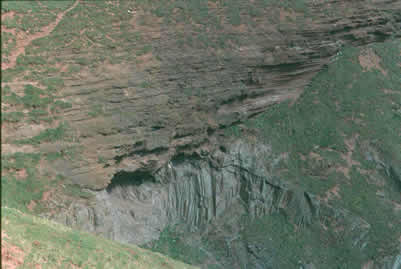
View of cliff section. Horizontal beds of Old Red Sandstone overly
vertical beds of Silurian greywackes.
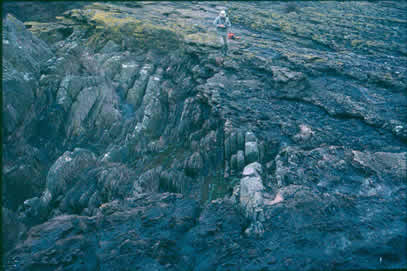
General view of the unconformity and the underlying
rocks.
Note that the vertically
bedded rocks exhibit pronounced
differential weathering.
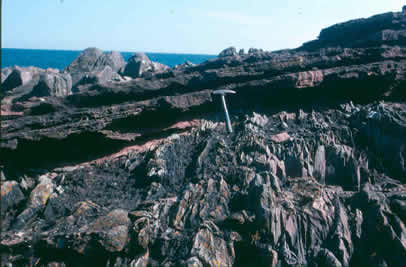
Planar nature of the unconformity. There is no
differential
weathering here.
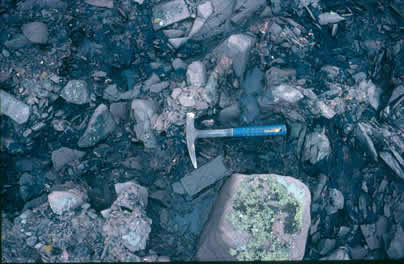
Breccia of greywacke material in the base of the
Old Red Sandstone.
Distinguishing features of the unconformity are as follows.
1. Sharp well-defined contact. It is very noticeable that the interlayered sandstones and shales which comprise the greywackes are not differentially weathered. At the contact, they have the same level. This is in marked contrast to where the Silurian rocks are exposed to modern-day weathering - examples are found wherever the greywackes lack their covering of Old Red. The shales are eroded more quickly than the sandstones and the latter stand out like ribs. This is a very important observation, as it puts constraints on the mechanisms of erosion considered and on the timespan of erosion.
2. Basal Breccia. At the base of the Old Red is a coarse breccia of less than a metre thickness with inclusions of Silurian greywacke. The rock fragments are sub-angular, showing little evidence of reworking. This again provides a time constraint between the erosion of these fragments and their deposition.
3. Old Red Sandtone bedded units. The Old Red is composed of thick depositional units, with both parallel-bedded and cross-bedded sedimentary structures. These observations suggest a high energy environment and rapid deposition.
4. Calcite deposits below the unconformity. In some places, the rocks below the unconformity appear fragmented, and there are minor deposits of calcite. It has not yet been possible to determine how extensive these features are, although it is thought that they are fairly localised. This may be interpreted as a form of weathering of the eroded surface, with some elapse of time before the deposition of the Old Red. However, the limited nature of current field observations may permit alternative interpretations.
The Silurian rocks show a very sharp erosive horizon with no differential weathering. This suggests very high energy erosive processes levelling the greywackes. The presence of the fragmented areas with calcite deposits suggests that there was a time interval during which some alteration of the rocks below the erosion surface took place. However, the localised nature of the calcite suggests that this time lapse cannot have been very great. (Field evidences elsewhere show that the Lower Old Red Sandstones unconformably overlie the greywackes, and that the Upper Old Red Sandstones unconformably overlie both greywackes and Lower Old Red. Therefore, some time lapse should be expected).
The observations relating to the Upper Old Red Sandstones suggest very
high energy environments and the rapid deposition of beds. There would appear
to be no controversy about this. The general view is that they are the results
of flash flooding, and this is the interpretation presented in the Geological
Survey handbook:
-
"The Upper Old Red Sandstone sediments appear to have been deposited over
a slowly-subsiding area subjected to periodic flooding and dessication.
The local basal conglomerates represent the products of torrential stream
erosion but as subsidence and deposition went on this early phase gave place
to one of shallow continental basins" (Macgregor and Macgregor, 1948, page
31).
None of the field evidences noted above requires there to be long periods of time to form the unconformity. Long timescales are introduced by presupposing slow rates of folding and uplift of Silurian sedimentary rocks, slow rates of erosion, slow rates of subsidence and slow rates of supply of Old Red sediments. None of these factors are required by observational data.
Newton Point, Arran
The importance of this locality was recognised by Hutton in 1787. It is small in outcrop: just over 300 metres in length along the coast. In this locality, the rocks below the unconformity are Dalradian schists (Late Precambrian). The overlying rocks have been variously classified as New Red Sandstone, Carboniferous Sandstone, and Old Red Sandstone. All these rocks are found elsewhere on Arran. The current consensus is to assign the rocks, on lithological grounds, to the Upper Old Red Sandstone. This puts this unconformity stratigraphically at a similar level to the unconformity at Siccar Point. The overlying rocks dip north-northwest at an angle of about 30° , and the underlying schists dip to the south-southwest at angles between 40°and 50°. The schists would have been approximately vertical at the time of deposition of the sandstones.
Hutton's description is found in his Theory of the Earth (1795,
page 429 and 1899, pages 235-236). This quotation is from the latter:
-
"Here the first thing that occurs is the intermediate junction of the inclined
strata of schistus and the other strata, which here appear to be a composition
of sandstone and limestone; these strata are equally inclined with the schistus,
but in the opposite direction. These two different kinds of stratified bodies
rise to meet each other; they are somewhat confused at the immediate junction,
but some of the sandstone or calareous strata overlap the ends of the alpine
schistus."
Immediately above the unconformity is a breccia of Dalradian material, analogous to that at Siccar Point. There are numerous evidences of high energy deposition: with cross-bedding being prominent. However, there are only a few metres of Old Red Sandstone to investigate at this locality.
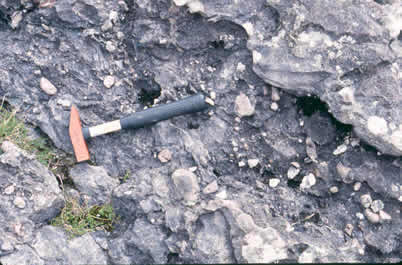 |
Breccia of Dalradian material in the Old Red Sandstone
at Newton Point, Arran. |
The analogy with Siccar Point is very close. Both sites suggest far higher energy levels and more rapid processes in operation than had been recognised by Hutton.
Geological context and interpretative models
The generally accepted interpretation of the Siccar Point rocks is as follows. Closure of the Iapetus Ocean during the Silurian produced the folding and elevation of the Silurian greywackes. This is known as the Caledonian Orogeny. Subaerial erosion processes produced the relict topography in a desert environment. The localised fragmentation of the greywackes and the deposition of calcite represent the formation of a fossil soil, where water carrying calcite found its way to the surface and evaporated leaving calcite behind. The area began to subside slowly and flash flooding brought down Old Red sands and conglomerates to cover the erosion surface.
The question being asked is: how much of this scenario is required by the field evidences, and how much is deduced from presuppositions? What evidence is there for flash flooding? Or is it just assumed that because material is red and conglomeratic, it must be associated with flash flooding? (Sheet conglomerates are different from fan conglomerates, and it is the latter which should be associated with flash flooding. Other mechanisms of a more catastrophic nature may be better associated with sheet conglomerates). How extensive is the surficial fragmentation and calcite deposition? Does the "fossil soil" hypothesis stand up to investigation? What is to be made of the lack of differential weathering? an observation that is not addressed in the consensus view outlined above.
It is worth noting that modern studies of these unconformities have not been published. There is consequently a lack of data and greater scope for differing interpretations. A full discussion of these matters lies outside the scope of this note. However, sufficient has been said to show that Hutton's interpretation does not necessarily follow from the field evidences but it appears to have been imposed on them. The empirical data are consistent with, and favour, geological catastrophism.
These sites are traditionally linked to Hutton's "rock cycle", often abbreviated to "The rock cycle". Students of geology are introduced early to the concept of uniformitarianism: present day slow rates of geologic activity are the basis for interpreting the rock record. Few appear to familiarise themselves with the controversies that surrounded this concept from its inception. Georges Cuvier (1825) was one of the leading geologists of his day who was convinced that uniformitarian processes are totally inadequate to explain past geologic activity: "We now propose to examine those changes which still take place on our globe, investigating the causes which continue to operate on its surface This portion of the history of the earth is so much the more important, as it has been long considered possible to explain the more ancient revolutions of its surface by means of these still existing causes
But we shall presently see that unfortunately this is not the case in physical history: the thread of operations is here broken, the march of nature is changed, and none of the agents that she now employs were sufficient for the production of her ancient works." (page 12).
It is argued in this paper that these key historical sites do not substantiate the uniformitarian approach. Tyler (1990) proposed an alternative rock cycle based on the tectonic control of geological processes. This rock cycle is amenable to catastrophist interpretations of orogenies, erosion, deposition and metamorphism. It is suggested to be a more appropriate interpretative framework for understanding Hutton's unconformities. John Playfair's (1805) concluding comments are a fitting conclusion for this paper: "We returned, having collected, in one day, more ample materials for future speculation, than have sometimes resulted from years of diligent and laborious research".
Endnote: This paper is essentially a draft document, to be modified as a result of discussion. Feedback is therefore invited via BCS.
David J. Tyler
References
Craig, G.Y. 1975. Siccar Point, Cove, Catcraig. In: Craig, G.Y. and Duff, P.McL.D. (eds). The geology of the Lothians and South East Scotland. Scottish Academic Press, Edinburgh.
Cuvier, G. 1825. Essay on the theory of the earth. 3rdedition. Blackwood, Edinburgh.
Hutton, J. 1795. Theory of the Earth, with proofs and illustrations. Volume 1.
Hutton, J. 1899. Theory of the Earth, with proofs and illustrations. Volume 3. Geikie, A. (ed). Geological Society of London, London.
Macgregor, M. and Macgregor, A.G. 1948. The Midland Valley of Scotland. 2nd edition. HMSO, Edinburgh.
Playfair, J. 1805. Biographical account of the late Dr James Hutton. Trans. Roy. Soc. Edinburgh. 5, 39-99.
D.J. Tyler, 1990. A tectonically-controlled rock cycle, In: Walsh, R.E. and Brooks, C.L. (Eds): Proceedings of the Second International Conference on Creationism, Creation Science Fellowship, Inc., Pittsburgh, PA, Volume II, 293-301.

